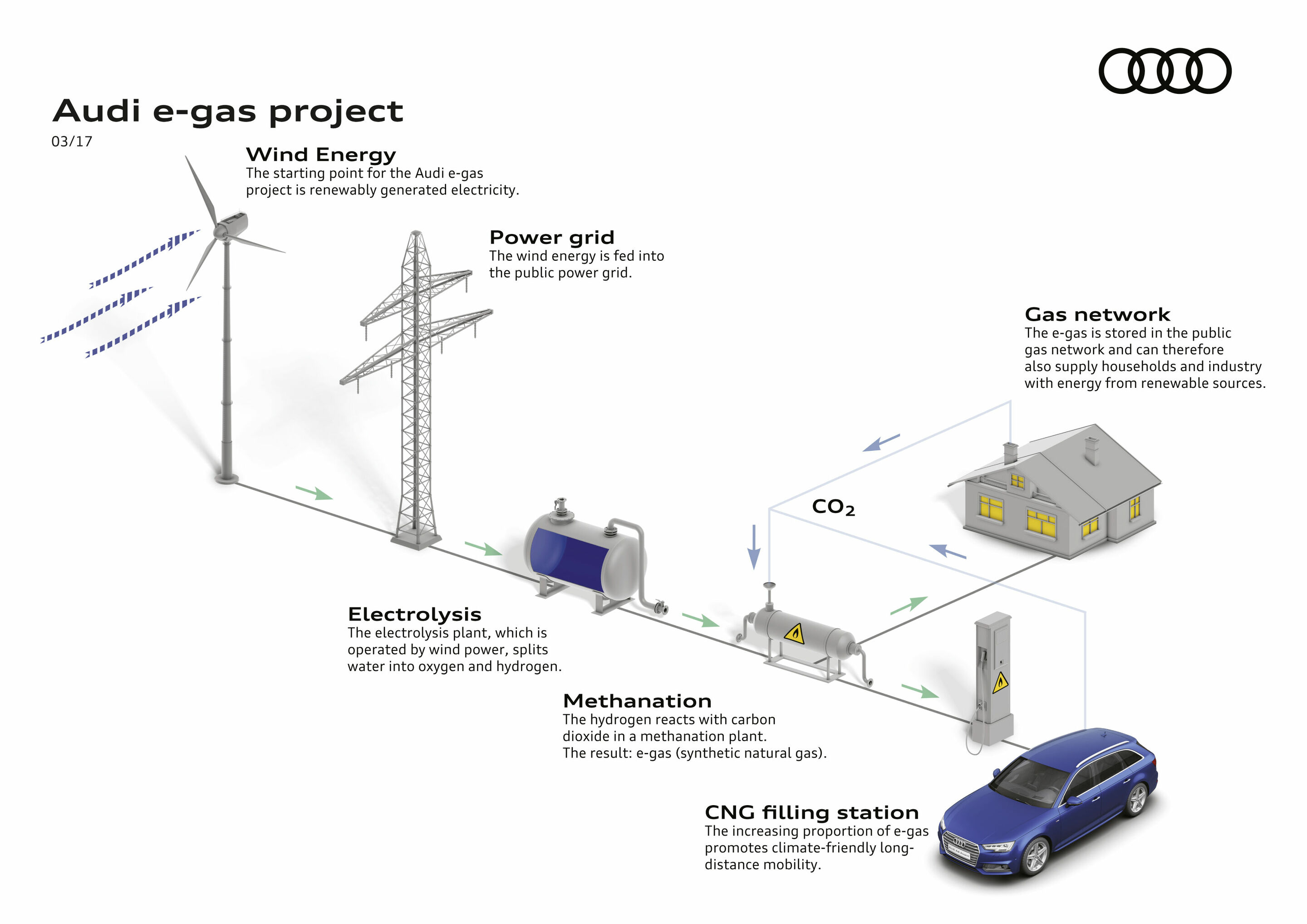New Audi e-gas offer as standard: 80 percent lower CO2 emissions
- Audi g-tron models to run for three years on Audi e-gas as part of special standard package deal
- Offer begins immediately and will be valid until May 31, 2018
- Orders for A4 Avant g-tron and A5 Sportback g-tron can be placed in Europe beginning in early summer
- The sustainable Audi e-gas fuel binds as much CO2 during its production as the car releases during combustion
Audi is presenting a very sustainable offer: The automaker is now offering customers climate-friendly Audi e-gas to power the A3 Sportback g-tron* – the fuel offer is included as standard and customers will pay only the regular natural gas price. With this deal, Audi is reducing the CO2 emissions of the g-tron fleet when running on gas by 80 percent**. Early this summer Audi will further expand its product range with two new models – the A4 Avant g-tron* and the A5 Sportback g-tron*, and the e-gas offer as standard applies to both models.
Compared to a gasoline-powered car in the same performance class, the Audi g-tron models cut CO2 emissions by 80 percent. The green fuel Audi e-gas is what makes this reduction possible. This fuel is produced using renewable energy from water and CO2 or from organic residual materials like straw and plant clippings. During its production, the Audi e-gas binds exactly the amount of CO2 as is emitted by the car during combustion. Beginning immediately, Audi customers who order the A3 Sportback g-tron by May 31, 2018, will have access to their supply of this fuel for three years as part of the standard package. “This offer is our next step in climate-neutral, long distance mobility. Our promise to the customers is: no compromises. The g-tron models are sporty, sophisticated and progressive – like every Audi. And with Audi e-gas they are also very climate-friendly on the road,” said Dietmar Voggenreiter, Member of the Board of Management for Sales and Marketing at AUDI AG.
Audi and its partners are producing the Audi e-gas with several processes and facilities in Germany as well as in a number of other European countries. Among other places, the brand obtains e-gas from its own power-to-gas facility in Werlte, a town in the German state of Lower Saxony. The process uses mostly excess green electricity to operate three electrolyzers, which break water down into oxygen and hydrogen. In the methanation process that follows, the hydrogen reacts with CO2. This produces synthetic methane – the Audi e-gas. The fuel is fed into the European natural gas grid and replaces the amount of natural gas that the g-tron model consumes in the New European Driving Cycle (NEDC).
Customers fill up their g-tron models at any CNG fueling station and pay the regular price for the fuel. By feeding the computed volume of Audi e-gas into the natural gas grid, Audi works behind the scenes to ensure the green benefits of the program, including the corresponding reduction in CO2 emissions. A fuel card is no longer used as the accounting tool. Instead, Audi automatically calculates the quantity on the basis of collected data and service data from the cars. TÜV Süd, a German testing and certification corporation, monitors and certifies the process. Audi g-tron customers receive a document that confirms their car will be supplied with Audi e-gas and informs them about the certification.
The family of g-tron models will continue to grow this year. In addition to the Audi A3 Sportback g-tron, Audi will soon have two more CNG models on the market. The Audi A4 Avant g-tron and the Audi A5 Sportback g-tron will be launched in early summer. Both models will be powered by a 2.0 TFSI engine with a power output of 125 kW (170 hp). The tank module, which consists of four gas tanks with a total capacity of 19 kilograms (41.9 lb) and a 25-liter (6.6 US gal) gasoline tank, allows for a range of up to 500 kilometers (310.7 mi) when the cars are running in pure CNG mode. The overall range can reach up to 950 kilometers (590.3 mi).
Fuel consumption of the models named above
Audi A3 Sportback g-tron:
Combined fuel consumption in l/100 km: 3.6 - 3.3***;
Combined fuel consumption in l/100 km: 5.5 - 5.1*** (42.8 - 46.1 US mpg);
Combined CO2 emissions in g/km (CNG): 98 - 89*** (157.7 - 143.2 g/mi);
Combined CO2 emissions in g/km (gasoline): 128 - 117*** (206.0 - 188.3 g/mi)
Audi A4 Avant g‑tron:
CNG consumption in kg/100 km: 4.4 - 3.8***;
Combined fuel consumption in l/100 km: 6.5 - 5.5*** (36.2 - 42.8 US mpg);
Combined CO2 emissions in g/km (CNG): 117 - 102*** (188.3 - 164.2 g/mi);
Combined CO2 emissions in g/km: 147 - 126*** (236.6 - 202.8 g/mi)
Audi A5 Sportback g-tron:
CNG consumption in kg/100 km: 4.3 - 3.8***;
Combined fuel consumption in l/100 km: 6.4 - 5.6*** (36.8 - 42.0 US mpg);
Combined CO2 emissions in g/km (CNG): 115 - 102*** (185.1 - 164.2 g/mi);
Combined CO2 emissions in g/km (gasoline): 144 - 126*** (231.7 - 202.8 g/mi)
*** Figures depend on the tires‑/wheels used as well as the transmission version
** In pure e-gas mode (CNG) with a well-to-wheel analysis (a life cycle assessment that includes fuel production and normal driving of the automobile), in comparison with an equivalent model in the same performance class with a conventional gasoline engine.
